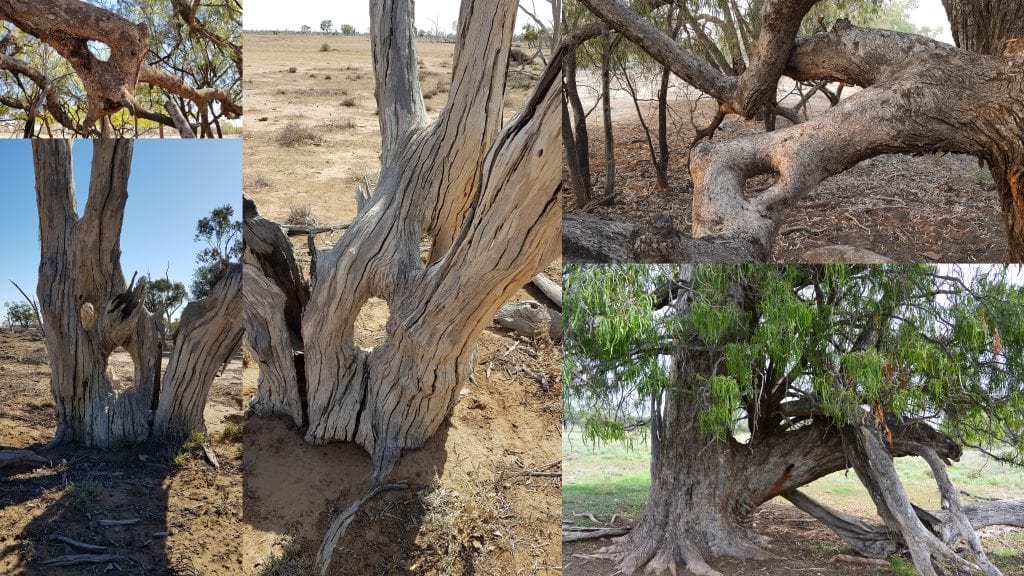THEY BLOODY WELL LIKED THEM…..
Mustering for lambmarking and shearing has brought me face to face with some old scartree friends and a startling introduction to a few new ones. I came across a dead double Ring with pointer in an area I know well but didn’t notice it before. The trees are all dead in this place as the tail end of an old boredrain pooled there. Artesian water lying around on the surface kills most of the trees over time because of its high mineral content but lignum and sometimes saltbush seem to tolerate it. Anyway this area has many coolamons & multiple scars even an exceptional triple coolamon carved mosaic pattern. The double Ring is low to the ground and hard to spot except from a particular angle looking north. Such a treasure, a national treasure really but as unseen & uncelebrated as the rest.
The second and perhaps the most interesting of all Rings is on a neighboring property hidden from view and giving rise to the simplest of all Ringtree theories. THE REASON THIS KAMILAROI CLAN CREATED SO MANY RINGTREES HERE OVER THE YEARS IS BECAUSE THEY BLOODY WELL LIKED THEM! The small branch Ring is found under the canopy of an old spreading coolabah that has been planted round the drip line with whitewood, rosewood, wild orange & wilga. This special camp is in the red center of a complicated billabong system on the eastern edge of the big warrambool. Ideally situated for the gathering of aquatic food in flood times and close to the stoneworking flats & sandhill sanctuary. The ring of leopardwood Rings is also in the general vicinity and although the land system is spread over four different properties now it would have belonged to one particular clan pre 1788.
So not only did these people like the look of Ringtrees but they had a special knowledge in how to create them. If you think it would be easy I suggest you give it a go in your own backyard. This knowledge of tree splicing or limb fusing must have been gathered over eons. They also knew how to grow trees inside other trees so you have 2 different species growing out of one root system. Not grafted as such but the original tree is used as a kind of planterbox. The host tree is generally a bimble box ( buubaya – Eucalyptus populnea ) and the parasite tree wilga ( dhil – Geijera parviflora ) or wild orange ( bambul – Capparis mitchellii ). Yes I’m sure seed can fall into old decaying coolamons or get pooped down the trunk by birds to germinate in nooks, but to take root there & grow? In this climate? If this phenomena occurs naturally why do the tree in trees only occur near other CMTs on popular camping grounds?
I think we need to get away from this “noble savage” view of Indig. history and see the pre 1788 population as creative individuals who worked as a team but also did things for the love of it. Not all activities had to be deep and meaningful. Life was not short and brutish as we have been led to believe. There was plenty of time for song & dance, storytelling, cave & body painting, wood carving & sculpture etc. Wood working was one of those necessary survival skills but an everyday coolamon could be transformed into a work of art by individual design & engraving. Woven waterproofed dilly bags, animal skin water carriers and even clay storage vessels have been used to transport & keep food ( see chap. 4 of Bruce Pascoe’s Dark Emu ). Ringtrees are a just an advanced form of woodworking with the timber still alive & attached to the tree. Some individuals would have what we now call ‘green thumbs’ and be able to bend, twist and shape sappy wood to get the desired form without killing the tree. This process was more like sculpture than carpentry and the work of artisans some centuries ago. I bloody well like them too …

